Africa is the new front for rare earths supply

Explorers pile into Africa as the West hunts a non-Chinese rare earth lifeline. Pic: Getty Images
- Africa moving to the front line of rare earth diversification
- Continent holds unique position due to its combination of geological endowment, geopolitical neutrality and untapped development potential
- These ASX developers and explorers are positioning themselves early
Geopolitical risk has become the dominant variable in rare earths supply making Africa, one of the few regions offering large undeveloped resources and political neutrality, a logical target for diversification.
ASX companies are entering African jurisdictions early to align with future non-China supply requirements rather than competing for mature assets later.
The surge in ASX rare-earth names after the Trump–Albanese pledge illustrates the new policy reality that western governments will pay to gain control of their critical minerals supply chain.
The US$8.5bn framework, EXIM/EFA letters and Pentagon price-floor mechanisms have made Australia the test case for underwriting non-Chinese supply, but if the intent is to wrestle control away from China, Australia alone cannot carry the tonnage or diversity of feed needed.
Faster permitting for resources to hit this decade
Africa hosts multiple Mrima-style, Kameelburg-style and Kangankunde-style systems and remains largely non-aligned in the tech minerals rivalry.
That neutrality gives US, EU and Japanese buyers supply that can be qualified as “politically safe” under emerging IRA/CRMA rules.
Namibia, Malawi, Tanzania, Kenya and Botswana can move projects through approvals faster than the US or EU, lifting the probability that African tonnes will hit the market this decade rather than the next.
With export credit banks demonstrating in Australia that price floors, concessional debt and strategic offtakes can change project economics, they are poised to rinse and repeat wherever neutral tonnes exist.
China, of course, is looking to stake its own claim on projects on the African continent, with major producer Shenghe Resources completing a takeover this year of Tanzanian developer Peak Rare Earths (ASX:PEK).
That geopolitical tension could put a premium on the next generation of development stories. Let’s take a look at some of the key movements by ASX companies to build new rare earth projects in Africa.
RareX secures US$50m facility
RareX (ASX:REE) is a case in point, having secured a US$50m discretionary facility with GEM Global Yield to accelerate development of the Mrima Hill REE-niobium system in Kenya should its consortium with Iluka Resources (ASX:ILU) be awarded the project.
The asset has a non-JORC, NI43-101 resource of 150Mt grading just under 4% total rare earth oxides with 0.7% niobium along with other metals.
It sits in the top tier globally for undeveloped rare earth tonnage, just 15km from a major port corridor and could feed directly into Iluka’s Eneabba refinery in WA under the proposed SPV structure.
Its strategic location contrasts sharply with a lot of rare earths projects, which are typically inland and landlocked.
Should the consortium succeed in acquiring the project, it could become a very meaningful project for Kenya and represent the initiation of a critical minerals hub in Mombasa.
Aldoro drills deeper at Kameelburg
Aldoro Resources’ (ASX:ARN) Kameelburg REE play sits in Namibia, arguably the most financeable mining jurisdiction in Africa.
Kameelburg is advancing in a Fraser-ranked country with a demonstrated history of critical-minerals permitting, positioning Aldoro to tap the same style of Western funding and offtake mechanics already seen in Australia, but in a geography closer to European buyers.
The company is zeroing in on the same high-grade niobium zones that returned up to 4.14% in earlier hits with phase 2 drilling underway.
The 14-hole for ~9000m campaign is the first to use the new Nock 800 rig, which can punch holes down to 750m, opening up deeper parts of the system along the western margin of the intrusion.
Aldoro recently lifted Kameelburg’s inventory by 85% to 520.61Mt at 2.49% TREO-equivalent, including a core of 271Mt at 2.90% TREO-equivalent and a further 231.59Mt at 0.24% niobium, placing the asset in the same conversation as Canada’s Saint-Honoré.
Lindian’s site now build-ready
Lindian Resources (ASX:LIN) represents the development-maturity end of the African stack in Malawi.
The company recently hit another milestone at its Kangankunde asset, confirming that the early works package has finished on time and on budget.
That phase, led by Mota-Engil, delivered what was needed to convert a drill camp into a construction-ready mine site including a 5.5km access road, cleared administration areas, security infrastructure, utilities and laydown facilities.
Mota-Engil plans to demobilise this month ahead of site hand over for the next build phase.
At the same time, the team is finalising the process-plant build tenders to ensure the project stays aligned with the DFS capital envelope and a 2026 first-product target.
To keep schedule risk low, Lindian has also pre-ordered its owner-operator mining fleet, all due to be on site for a January 2026 mining start.
DY6 checks options while suitors circle
DY6 Metals (ASX:DY6), which is primarily focused on its mineral sands assets in Cameroon, is positioned earlier in the curve and has begun a strategic review of its Malawian rare earth portfolio after fielding unsolicited interest from multiple industry groups.
The company has hired a rare-earth specialist to map the best way to monetise Tundulu and Machinga – whether that’s a JV, a farm-in, a sale or a dedicated REE spin-out.
Tundulu has returned thick TREO hits with gallium credits from surface, while Machinga has delivered heavy-REE and niobium at mineable widths within 40km of Lindian’s Kangankunde.
Fieldwork is continuing with soil and rock chip programs across high-priority targets at Machinga now complete with samples heading to the lab in the coming weeks.
Ionic’s clay-hosted rare earth play in Uganda
And Ionic Rare Earths (ASX:IXR) brings a different flavour to the African pipeline with its Makuutu ionic clay rare-earth project in Uganda, one of the very few clay-hosted systems outside China advancing toward development scale.
The company was granted a Large Scale Mining Licence for the project in early 2024 and targets first production in 2026.
Makuutu comprises nine licences covering around 300km2, located 120km east of Kampala with defined mineralisation stretching over 37km.
Its MREC product basket has one of the highest heavy rare earth contents identified to date, consisting of ~45% medium and heavy rare earths.
At Stockhead we tell it like it is. While RareX, Aldoro Resources and DY6 Metals are Stockhead advertisers, they did not sponsor this article.
Related Topics

UNLOCK INSIGHTS
Discover the untold stories of emerging ASX stocks.
Daily news and expert analysis, it's free to subscribe.
By proceeding, you confirm you understand that we handle personal information in accordance with our Privacy Policy.








